Pity the poor motorcycle designer who has to come up with an entry-level or beginner’s motorcycle. Make it too big, powerful or heavy and potential buyers will be intimidated. Make it too small and light and folks will scoff and quickly outgrow it. Make it too expensive and it will languish on showroom floors. Seems like a tough assignment, to say the least.
With the 2006 Ninja 650R, Kawasaki’s designers have walked this tightrope quite successfully. Starting with a fresh-looking sporty design, powered by a lively new 649cc twin and mounted in a competent chassis, we think Kawi’s engineers deserve a round of applause.
Team Green’s intended market for this machine is new riders and those who are shopping for their first new bike, re-entry riders coming back to the sport, and multibike owners looking for a reasonably priced second or third motorcycle for their spouse or visiting friends to ride. But if you don’t fit into one of these demographics, I’m sure they’ll sell you one anyway.
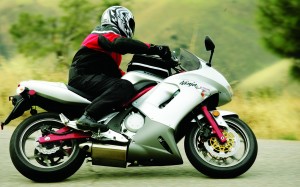
Conservative graphics and a choice of three tasteful colors (black, red or silver) add to the bike’s grown-up visage. That wind-cheating fairing effectively directs the wind blast away from the rider while at the same time giving the 650R a distinct look of its own. Windscreen protection is above average for this class of bike and helps take the windblast off the rider’s torso. Although your head is still in the breeze, helmet buffeting is almost non-existent.
Motive power comes from a torquey little 649cc liquid-cooled parallel twin with twin camshafts and four valves per cylinder. While similar in layout and design to the EX500’s engine, this is a brand-new design that Kawi says is even smaller externally than the 500. Shim-under-bucket valve lifters allow a long 26,000-mile adjustment interval. To quell vibration the 180-degree crankshaft is paired with a single counterbalancer shaft.
The Keihin digital fuel-injection system with 38mm throttle bodies eliminates the need for a cold-start lever. Cold and hot starts are instant and the bike is immediately ready to ride. Drivability is excellent and throttle response is free of abruptness coming off idle and smooth throughout the operating range.

There’s enough thrust available to keep most riders happy, especially in the tight, twisty stuff. Power starts to build nicely in the midrange, climbing to a peak of 62.1 horsepower at 9,000 rpm, then tapering off until hitting the rev limiter. Peak torque of 41.5 lb-ft occurs at 7,250 rpm, with a relatively flat graph line. There’s surprisingly little vibration at all engine and bike speeds. Just a modicum can be felt through the gas tank and grips when it’s revved up.
Lever effort with the cable-actuated wet clutch is light and modulation easy. Although it feels like it chatters when engaged at low rpm in first gear, this is actually due to the cylinders’ power pulses being transmitted through the drivetrain, rather than being a faulty clutch. Rev it up a little higher when you start out and the sensation goes away.
Shifting is quick and smooth with the six-cog tranny and it never missed a shift. Neutral is sometimes a little tricky to access when stopped, although that seemed to improve as the bike broke in. The footpegs are fairly high for good cornering clearance, and this means that taller riders will feel a bit cramped for legroom. Most, though, will find the riding position comfortable and relaxed.
Although the industry trend had been toward underseat exhausts, this year under-engine midship mufflers are in, and Kawasaki’s engineers have jumped on the bandwagon. This helps keep weight low, heat away from the rider(s) and luggage, centralizes mass and makes the bike look more symmetrical and less cluttered. The exhaust note is quite muted and sounds like it comes in well below the EPA’s maximum noise-level standards. A built-in catalyst also keeps emissions within limits.
In addition to the already narrow engine, Kawasaki’s engineers designed a simple but effective offset single-shock rear suspension and relocated the battery to make the bike even narrower. These changes, along with a thin contoured saddle, make it easier for riders to put their legs down closer to the bike. This allows shorter riders to feel more comfortable on it despite its 31.1-inch seat height.
On the road the 650R feels light and nimble, with a tight turning radius, yet it’s steady and secure at high speeds. The tubular steel swingarm has been made longer than typical for a bike of this type to add stability. Turn-in effort feels a tad higher than some other bikes in its class, but the high, wide handlebar offsets the difference and most riders won’t notice it unless they ride quicker-steering bikes back-to-back.
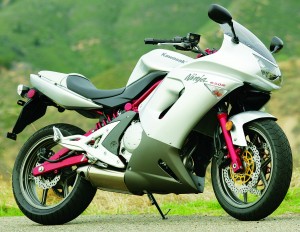
Gearing is well suited to the 650R. First allows it to putt along in heavy traffic at a fast walk without constantly slipping the clutch, the intermediate close-ratio cogs are well spaced, and sixth gear gets you a moderate 4,250 rpm at 60 mph. Even at speeds of 80 mph and higher there’s still sufficient reserve power on tap for passing or hill climbing.
Instead of clip-ons, a conventional handlebar provides the rider interface. This allows a comfortable upright seating position and also lets the owner change the bar for a custom fit without incurring a lot of expense. Mirrors are steady, farther apart than most sportbikes and provide a reasonable view aft.
A duet of conventional analog gauges greets the rider; basic but functional. At the left is a 140-mph speedometer, while an 11,000-redlined tachometer fills the right side. The rider can toggle between choices of the digital odometer, twin tripmeters and a clock. A bright LED located within the tach face warns you when you’re starting to get too much air in the gas tank. This typically occurs at 130-140 miles, based on our fuel economy, which ranged from 42.6 to 47.8, averaging 43.4 mpg. At that average, you should be able to squeeze about 178 miles out of the bike before you have to start walking.
Controls are similar to other Kawasaki sportbikes, with some nice touches. Both clutch and brake levers are adjustable, and there’s also a four-way hazard flasher. Lighting is strong and effective. The twin-headlamp assembly kicks out plenty of light on either beam, the gauges are easy to see after dark, and the turn signals are refreshingly redesigned after years of Kawasaki’s using the same style across the model line.
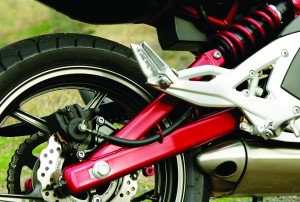
Passenger accommodations are a bit cramped, with fairly high and aft-mounted footpegs that can cause the passengers feet to hit the rider’s, along with a thin, tapered seat that’s difficult to hang onto because there’s no grab rail. Once you figure out where the hidden lock is, you’ll find a toolkit and room for the owner’s manual and documents under the seat. We like the two-tone color scheme, which gives it a solo-saddle appearance with a tail piece.
Cool-looking, slightly petal-shaped brake rotors are used; two in front and one aft. Twin-piston sliding front calipers are fitted; a single-pot sliding caliper is employed in back. We found braking to be strong, easy to modulate and consistent, with light lever effort. The high-compression twin-cylinder engine also provides considerable compression braking, so you should never lack stopping force.
Bridgestone Battlax BT020 tires were spooned onto our test bike at the factory. These are a good match for the 650R, providing a nice balance of handling and braking grip, along with reasonable wear characteristics. They also deliver good feedback, dry and wet traction, and don’t chase pavement seams and rain grooves.
Ride quality is one of the areas where price plays a role. Damping rates are non-adjustable at both ends, and we found the bike to be a tad harsh over sharp-edged bumps, and repetitive pavement seams send it hopping. That said, handling is quick and confidence inspiring for beginners and experienced riders alike. The 650R holds a line through a corner nicely and feels stable at speed.
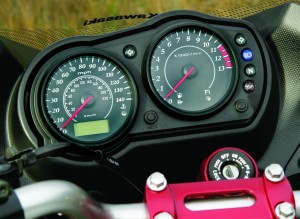
Mounting soft luggage can be a challenge due to the dearth of tie-down points. The passenger footpegs have holes for hooks, but they are a long way from the seat. Still, installing luggage can be done with a little creativity. With the steel gas tank, a magnetic tankbag can conveniently add cargo capacity.
Our test bike was trouble-free, nicely finished and did everything that was asked of it with aplomb. There’s enough power and handling ability to keep most riders enthused, yet it’s light and easy enough for most newbies to handle with confidence. All in all, Kawi’s new Ninja 650R is a practical choice for beginners or re-entry riders, commuters, or experienced veterans who want a responsive, fun-to-ride midsize street machine that’s inexpensive to buy and operate.
2006 Kawasaki Ninja 650R Review Specifications Chart:
Base Price: $6,299
Warranty: 1 yr., unltd. miles
Engine
Type: Liquid-cooled,
transverse parallel twin
Displacement: 649cc
Bore x Stroke: 83.0 x 60.0mm
Compression Ratio: 11.3:1
Valve Train: DOHC, 4 valves per cyl.
Valve Adj. Interval: 26,000 miles
Fuel Delivery: Keihin digital fuel injection, 38mm throttle bodies
Lubrication System: Semi-dry sump, 2.0-qt. cap.
Transmission: 6-speed, cable-actuated wet clutch
Final Drive: O-ring chain
E
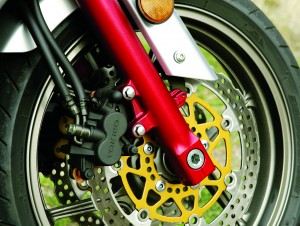
lectrical
Ignition: Digital electronic
Charging Output: 336 watts @ 5,000 rpm
Battery: 12V 10AH
Chassis
Frame: Tubular steel backbone w/ steel double-sided swingarm
Wheelbase: 55.3 in.
Rake/Trail: 25 degrees/4.2 in.
Seat Height: 31.1 in.
Suspension, Front: 41mm stanchions, no adj., 4.7-in. travel
Rear: Offset laydown single shock, adj. for spring preload, 4.9-in. travel
Brakes, Front: Dual discs w/ 2-piston pin-slide calipers
Rear: Single disc w/ 1-piston pin-slide caliper
Wheels, Front: Cast, 3.50 x 17 in.
Rear: Cast, 4.50 x 17 in.
Tires, Front: 120/70-ZR17
Rear: 160/60-ZR17
Wet Weight: 437 lbs.
Load Capacity: 401 lbs.
GVWR: 838 lbs.
Performance
Fuel Capacity: 4.1 gals., last 0.9 gal. warning light on
Average mpg: 43.4
Estimated Range: 178 miles
Indicated rpm at 60 mph: 4,250









I just bought this bike from someone who had it in a garage for years. It only had 1.600 miles on it…..does anyone know where to get a wiring diagram? The previous owner modified the wiring and some things are not working, I would like to rewire back to its original state.